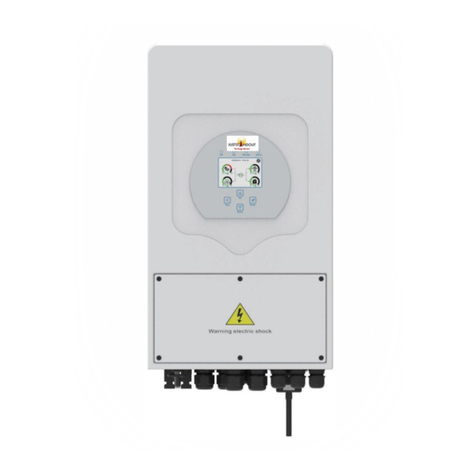
About This Manual
The manual mainly describes the product Information, guidelines for installation, operation and
maintenance. The manual cannot include complete Information about the photovoltaic (PV)
system.
How to Use This Manual
Read the manual and other related documents before performing any operation on the inverter.
Documents must be stored carefully and be available at all times.
Contents may be periodically updated or revised due to product development. The Information
in this manual is subject to change without notice. The latest manual can be acquired via
1. Safety Introductions
· This chapter contains important safety and operating instructions. Read and keep this manual
for future reference.
· Before using the inverter, please read the instructions and warning signs of the battery and
corresponding sections in the instruction manual.
· Do not disassemble the inverter. If you need maintenance or repair, take it to a professitional
service center.
· Improper reassembly may result in electric shock or fire.
· To reduce risk of electric shock, disctionnect all wires before aempng any maintenance or
cleaning. Turning off the unit will not reduce this risk.
· Caution: Tionly qualified perstionnel can install this device with battery.
· Never charge a frozen battery. · For optimum operation of this inverter, please follow required
specification to select appropriate cable size. It is very important to correctly operate this
inverter.
· Be very cautious when working with metal tools on or around batteries. Dropping a tool may
cause a spark or short circuit in batteries or other electrical parts, even cause an explosition.
· Please strictly follow installation procedure when you want to disconnect AC or DC terminals.
Please refer to "Installation" section of this manual for the details.
· Grounding instructions - this inverter should be connected to a permanent grounded
wiring system. Be sure to comply with local requirements and regulation to install this
inverter. · Never cause AC output and DC input short circuited. Do not connect to the mains
when DC input short circuits.
2. Product Introduction
This is a multifunctional inverter, combining functions of inverter, solar charger and battery
charger to offer uninterruptable power support with portable size. Its comprehensive LCD display
offers user configurable and easy accessible but on operation such as battery charging, AC/solar
charging, and acceptable input voltage based on different applications. - 01 -




























